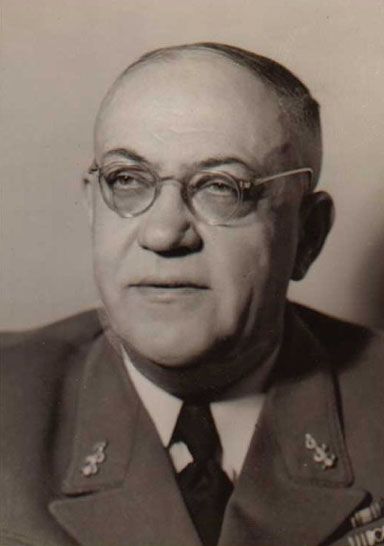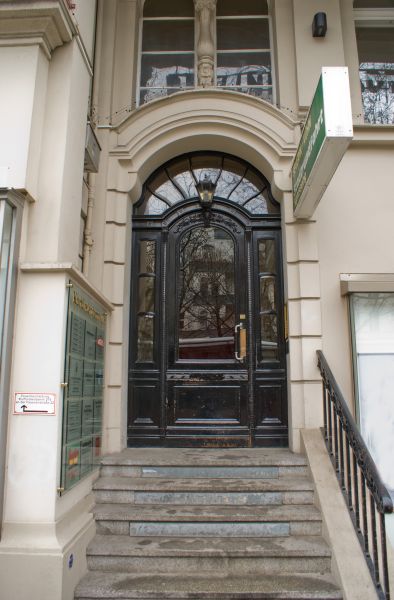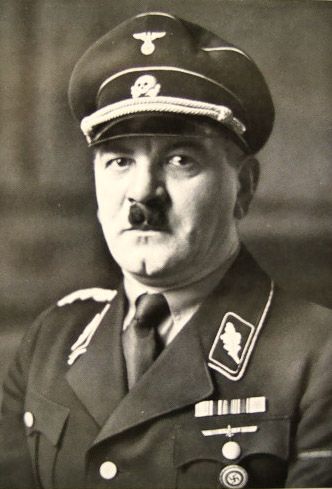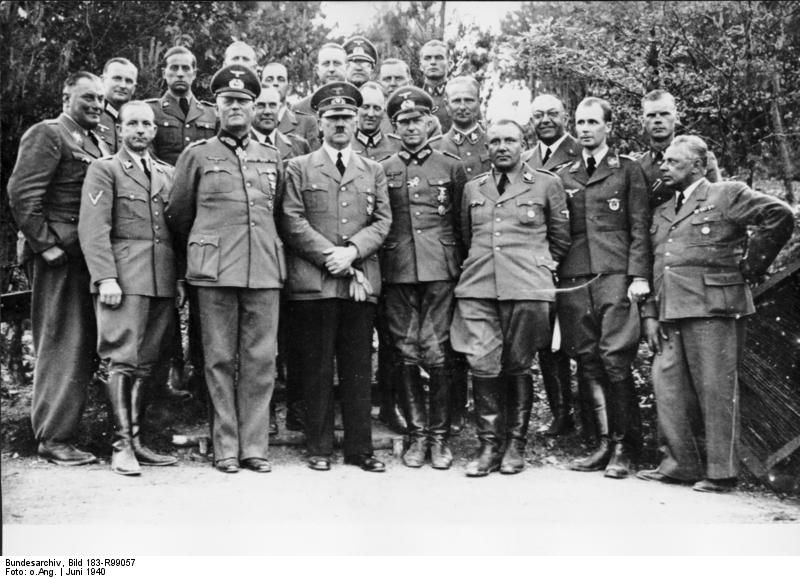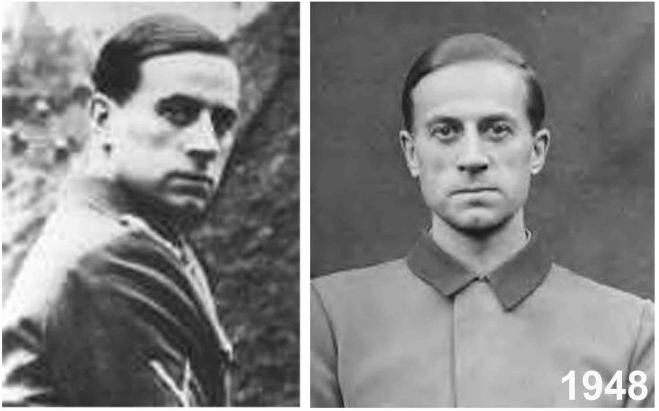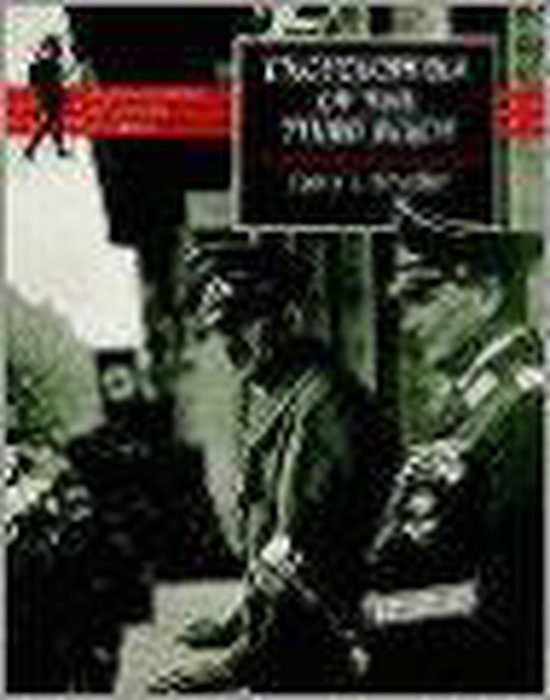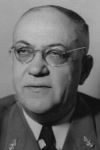Childhood and study
Theodor Gilbert Morell was born July 22nd, 1886 in Trais-Münzenberg in Hessen. He was almost three years older than his future, famous patient Adolf Hitler. His father was a teacher at a primary school, his mother came from a prosperous agricultural family from Hessen. Theodor had an elder brother Adolf and a younger sister Emilie. Adolf died of a stroke on November 1944 at the age of 61.
As a child, Theodor suffered from recurring stomach cramps but that did not prevent him from excelling as a student later on at secondary school. When his diploma was handed to him on February 16th, 1907, a note was added to the effect he had not had to take oral exams owing to his excellent achievements that year and to the quality of his written work. From the age of 16 to 19 he was trained as a teacher in Friedberg near Frankfurt am Main, subsequently he taught for a year in Bretzenheim near Mainz and afterwards he graduated in medicine at the University of Heidelberg with top marks. Next he went to France and studied medicine in Grenoble and parasitology in Paris. Thedor was also student guest at the Institut d’Accouchement Tornier. He returned to Munich in 1910. He received good reviews of a few scientific essays on immunology and psychiatry. In 1913 he wrote a dissertation on gyneacology, earning his physician’s certificate.
Images
Career and marriage
Morell became assistant-physician in Bad Kreuznach near Mainz. His tenure there was of short duration because he soon went to work as a ship’s doctor for the shipping company of Woehrmann. Subsequently he transferred to the Hamburg-South America company and then on to the Norddeutsche Lloyd. Altogether, he worked for a year as ship’s doctor. Later, Morell would state he had mastered his specific methods of treatment during maritine voyages to the tropics. Some time later he specialised in affections of the urinary tract. Around 1915, he bought a small practice in Dietzenbach, not far from Offenbach.
In the First World War, he initially served for a while as battalion physician on the western front and then as army doctor in a P.o.W. camp at Ohrdruf, Thüringen. In 1919 he bought a practice on the Bayreutherstrasse in Berlin where he was to live and work for the next 17 years. In 1920 Morelll married Johanna ‘Honi’ Möller, a wealthy actress. Their marriage remained childless. With the help of his wife’s riches, Morell was able to furnish his practice very lavishly. The next years, his business progressed very well. He acquired his upperclass patients through his wife’s contacts, by his state of the art practice and the high doctor’s fee he charged. Both the Sjah of Persia (now Iran) and the King or Romenia invited him to become their private physician but he rejected their offer. He liked his life in Berlin too much. In the early 30s, Morell was a fashionable and above all a prominent physician. He could afford to take only patients with enough money to pay his high fees. In 1932, his yearly income amounted to 150.000 Reichsmarks. Converted to the present value, that would amount to something like 500.000 Euros.
The seizure of power by the Nazis in 1933 was unfavourable to Morell. His name shield was plastered with the word Jude (Jew). Presumably because of his Jewish patients or, as he argued later, because of his somewhat Jewish appearance, his practice went downhill. Morell drew his conclusion and joined the N.S.D.A.P., although he continued treating Jewish patients for at least five years.
In 1935, he moved to he prestigious 216 Kurfürstendamm. His name shield read General Practitioner. His consulting room included an X ray room with the newest gadgets and a UV lamp. Morell went on to specialise in venereal affections.
Definitielijst
- First World War
- Took place from 1914 till 1918 and is also named The Great War. The conflict started because of increased nationalism, militarism and neo-colonialism in Europe. Two alliances battled one another during the 4-year war, which after a dynamic start, resulted into static trench warfare. The belligerents were the Triple Alliance (consisting of Great-Britain, France, and Russia; later enlarged by Italy and the USA, amongst others) on the one hand and the Central Powers (consisting of Germany, Austria-Hungary, Bulgaria and the Ottoman empire) on the other hand. The war was characterized by the huge number of casualties and the use of many new weapons (flamethrowers, aircraft, poison gas, tanks). The war ended in 1918 when Germany and its allies surrendered unconditionally.
Images
Heinrich Hoffmann, Eva Braun en Adolf Hitler
In the spring of 1936, via the professionl relations of his wife, Morell acquainted Heinrich Hoffmann from the world of movies. He lived in Munich, was the staff photographer of the Nazi party and a confidant of Hitler. (Bio Hitler) Hoffmann suffered from gonorrhea and wanted to be treated quickly by Morell. Initially, Morell didn’t care to travel to Munich as he had more than enough patients in Berlin. Hitler however dispatched his private plane to fly him to Munich. And so it came to pass that doctor Morell was introduced to the Reichskanzler in Hoffmann’s villa in the luxury suburb of Bogenhausen.
In that period, Hitler was very depressed because on May 16th, 1936, Julius Schreck had died from meningitis. Schreck had been co-founder of the SA and SS. Until he fell ill, he had been one of Hitler’s driver for years. Hitler was afraid Hoffmann would also pass away. Morell’s friend, Alois Becker, later remembered Hitler had been very pleased with Morell and had regretted he had not been there to treat Schreck. Morell succeeded in curing the photographer by administering anti-biotics from Hungary, among other drugs. Morell stayed in Munich for four weeks and subsequently accompanied Hoffmann on a recuperation trip to Vienna. Morell became Hitler’s confidant via Hoffmann.
Early summer 1936, Morell’s wife Johanna came to visit the Hoffmanns. Hoffmann pointed to a young girl and said to Johanna: "Do you see that blonde? That is Hitler’s girlfriend." Eva Braun worked for Hoffmann as office and laboratory assistant and she sometimes posed for pictures. She remained loyal to Hitler until their joint suicide in 1945. She too became one of Morell’s patients.
Hoffmann invited Morell and his wife to spend Christmas 1936 with him in Munich. On Christmas eve, Hoffmann suggested to the Morells to go to the Obersalzberg (Obersalzberg resort). Hitler was staying in the Berghof there. It was to be a Christmas mrs Morell would never forget. She said: "At a quiet moment, when everyone else was in the bowling alley, my husband and I sat down on a couch near the fireplace. Suddenly Hitler came in and said: Morell, do you have a minute?" The two men walked in the direction of the greenhouse, talking. It was to be the turning point in Morell’s life. "Bormann and Brandt came in," mrs Morell continued, "they had obviously noticed something, I realised later. They entered the greenhouse but Hitler sent them away! That was the moment my husband committed himself to Hitler.."Johanna Morell was not amused. She had a hunch as to what the two had been talking about. Direct as she was, she confronted her husband on his return: "What is this to us?" she snapped at him. "Why here of all places while we have a booming practice in Berlin!" The temptation was too big for Morell though. Probably he examined Hitler the very next day.
Hitler had stomach problems, suffered from flatulence and had rash on both legs. Morell would take up his treatment. Not a single physician had managed to cure Hitler. He promised Morell a house if he did succeed. Morell suspected the bacteria in Hitler’s intestinal tract to be the cause of his stomach problems. He treated him with Mutaflor capsules (a probioticum of the E-coli strain) of which Hitler had to take one or two after breakfast, augmented with huge doses of vitamins. After six months, Hitler could eat normally again without getting stomach cramps. His weight increased as well and the rash had disappeared. After nine months he was fit as a fiddle again. In reward, Morell was given VIP tickets for the Reichsparteitag in September 1937 in Nuremberg.
The Morell’s became regular guests at the Berghof. The succesful treatment by Morell and Hitler’s military successes around 1940 gave both men the idea that everything they touched would turn into gold. Morell started telling tall stories within his circle. He told for instance the fairey tale he had studied bacterial infections with the Russian Nobel price winner, microbiologist Ilja Iljits Metsnjikov (1845-1916).
Hitler fullfilled his earlier promise and assisted Morell in buying a house. He was granted a loan of 200.000 Reichsmark that was converted to a gift two years later. The Morells bought a luxurious house in the Berlin suburb of Schwanenwerder on Inselstrasse 24-26.
Hitler trusted Morell implicitly and did not listen to jealous rivals who attempted to warn Hitler of Morell’s unorthodox methods of treatment. At New Year 1937, the Morells, and Albert Speer, went to the Berghof together. The bond between Hitler and Morell seemed very strong. Sometimes Hitler visited the Morells on Sundays to have tea. He would take a walk in their garden and sit by the fire place. Once he even came to dinner unannounced, causing mrs. Morell to fly into a complete panic about what to serve him. Twice, Morell received an award. The first one was the Ritterkreuz des Kriegsverdienstkreuzes (Knight’s Cross for services in combat). This was presented to him by Hitler on February 24th, 1944. He received his second award, the Grand Cross of the Order of Saint Alexander, on June 8th, 1944.
Definitielijst
- Berghof
- A villa hidden deep in the Alps built at the top of the Obersalzberg near Berchtesgaden. This villa was property of Hitler and centre of the ”Alpenfestung”. The villa has an enormous complex of tunnels with a length of nearly 11 km. From the Berghof the Third Reich was ruled by Hitler and his close companions. Eva Braun, Hitler’s companion, spent a lot of time there.
- Nazi
- Abbreviation of a national socialist.
Images
Patients, enemies and in business
Meanwhile, Morell had become a much sought after physician and captains of industry such as Alfred Krupp and August Thyssen were among his patients. Aristrocrats such as Prince Philip of Hessen and Hitler’s adjutants were Morell’s patients as well. Albert Speer, Joseph Goebbels (Bio Goebbels), Joachim von Ribbentrop, Robert Ley, Alfred Rosenberg (Bio Rosenberg), generals, top actors and movie stars sat shoulder to shoulder in his waiting room.
At the start of the war in the west in April 1940, Morell followed Hitler to his western headquarters in Bad Münsterfeld. He felt an outsider within the close circle of men. He dressed in a grey uniform of his own design, adorned with gold ornaments but that did not make him more popular. Even Hoffmann started to turn away from him.
Other Nazis also talked less favourable about him. Heinrich Himmler (Bio Himmler) and Hermann Goering called him a quack doctor behind his back. Göring (Bio Göring) called him Reichsspritzenmeister (State’s master of injections) as he habitually started a treatment with injections. Ultimately, even Eva Braun did not want to have to do anything with him any more. She talked about him as if he had the manners of a pig and she refused to see him any more because of his dirty practice. Complaints about Morell to the Reichskanzler invariably triggered furious reactions. Hitler strongly believed in the ‘revolutionary treatments’ of Morell. An attempt by Dr. Karl Brandt, Hitler’s former private physician who did not trust Morell, to demonstrate to Hitler the detrimental consequences of the substances Morell administered to him, resulted in Brandt’s dismissal in 1944. Albert Speer made It clear in his memoirs he did not consider Morell to be a quack. He typified him as an opportunist who, after having reached the status of Hitler’s personal physician, he became extremely careless and sloppy in his work, far more concerned with his status and money than with providing medical care. Other medical men, including Karl Brandt, argued that Morell was slowly poisoning Hitler by injections with harmful drugs. The relationship between Morell and his wife increasingly resembled a one way street. He was away most of the time and her (love)letters remained mostly unanswered.
Businesswise, Morell also did well. He had financial interests in Hageda, the manufacturer of Mutaflor and in the Chinoin company in Budapest were a poor quality of sulfonamide was produced which Morell used frequently under its brand name Ultraseptyl. He also founded a company, Kosolup in the Sudetenland that had been captured by the Germans earlier. Since 1935 he had a 50% interest in Hamma, a pharmaceutical company in Hamburg. During the war, he delivered massive amounts of multivitamins and delousing powder to the army. He was clear about his motives: money. On top of his income as a physician, he wanted to make money in other ways in order to sustain his luxurious life style. After his death however, it transpired that there was nothing left of his business assets. He died in great poverty.
Definitielijst
- Krupp
- German family of steel and weapon’s manufacturers.
Images
Treatment of Hitler
Throughout the years, Morell administered more than sixty different drugs to Hitler. The Führer received a daily injection of some of them. It was not always clear which substances the drugs were made of but many believe that it affected both the rise as well as the downfall of Adolf Hitler. Morell administered a few substances to Hitler so often he must have become dependent on them, if not addicted to. These drugs contained opiates, codein and cocain. In 1936 amphetamines came on the market for the first time and Hitler could not keep his hands off them. In 1938, the King of Italy told his Minister of Foreign Affairs that Hitler was being injected with narcotics and stimulants. Morell had unlimited access to those substances. If Hitler actually had been addicted, it may well have affected his judgement and with it, the progress of the Second World War. The turning point of the war was the battle for Stalingrad. The progress of this operation is probably the best example of Hitler’s lack of sound judgment.
In 1943, Hitler’s complaints increased again. Possibly, the defeats at Stalingrad and in North-Africa contributed to this. Morell observed slight tremors in Hitler’s left arm and leg and clearly saw him dragging his left leg. Morell did not know exactly what caused it and was thinking about ‘brain fever’ (probably Parkinson’s disease). The doctor administered more and more drugs such as injections and pills with multivitamins under his own brand name Vitamultin. It is not unlikely that this drug, produced exclusively for Hitler, contained the stimulant pervitin. Pervitin is a meta-amphetamine which causes a sense of tirelessness and buoyancy. According to his adjutant Heinz Linge, before Hitler got out of bed each morning, he was given an injection by Morell which caused him to be alert, lively and so immediately fresh and ready for the day. Hitler’s reaction frequently was something like: "Morell, you are my saviour, I do not know how I made it through the night but here you are my saviour, you have cured me."
Following the attempt of July 20th by Von Stauffenberg, Hitler suffered from hemorrhage in his arms, bottom and his right ear. Morell treated this with penicillin which had been tested by the American army shortly before. Where he got it from is unknown and during interrogations by the American army, he claimed to know nothing about it. People from Hitler’s circle later stated that Morell had a major interest in a firm that marketed some sort of penicillin in a covert manner.
Definitielijst
- Führer
- German word for leader. During his reign of power Adolf Hitler was Führer of Nazi Germany.
Images
The end
On April 22nd, 1945, Hitler fired Morell unexpectedly. Morell writes in his diary: "On Saturday the 21st, Hitler was vey depressed. He must have had an important meeting the evening before. I wanted to give him another injection but he grabbed my arm and lost his temper. He yelled he knew exactly that I was going to inject him with morphine." Morell protested but Hitler screamed, was out of control and threatened to have him executed. Morell fell down to Hitler’s feet but he yelled he should leave, exchange his uniform for civilian clothes and go back to his practice on the Kurfürstendamm. With Hitler’s words still ringing in his ears, Morell went to the airport. He flew back to Munich in a Focke Wulf Fw 200 Condor.
Due to the tension and the flight (he hated flying) Morell was close to a heart attack. On arrival, he was taken to a clinic in Munich immediately. May 1st, 1945, he was transferred to a hospital in Bad Reichenall. Two days later, the area was captured by American troops. His wife visited him in hospital and found a crying, broken man. On May 18th, soldiers of the American 3rd army, looking for former SS officers, paid him a visit.
A few weeks later, his condition deteriorated. On July 17th, 1945, he was formally arrested and transferred to the prison hospital in Bad Reichenall. He even ended up in the same cell as his rival Karl Brandt for a while. The Americans listened in on their conversations. Later on, Morell was transferred to the former Luftwaffe interrogation center in Oberursel. Subsequently he was transferred via Darmstadt to Kornwestheim, then to Ludwigsburg and in the end, in early 1946, to the American prison camp for civilians nr. 29, beter known as the former concentration camp Dachau.
His health deteriorated further and in June 1946, he was admitted to the prison hospital in Dachau. He was partly paralysed on his right hand side. On October 12th, 1946, he was visited by a physician who had to determine if he was physically fit enough to testify in the so called Doctor’s Trial (NMT or National Military Tribunal). This proved not to be the case. Ultimately he became a burden to the Americans. Because of his bad health, the trial ended without his testimony.
On June 20th , 1947, he was released from Dachau. He was given a release note (Nr. 52160) in which he was acquitted of war crimes. An old American army coat, a few American socks and an army shirt several sizes too small was all he received in the form of clothing. The Americans took him to Munich railway station and left him there. Two hours later he was found by Red Cross volunteers. The once so prominent man in his lavishly decorated uniform now lay helpless on a stretcher in a Red Cross station, his hair tousled, his face pale and mumbling to himself. The papers he was given in the prison hospital contained notes to the effect that he suffered from serious heart problems, that he was unable to work and suffered from an aphasic speech disorder as a result of brain damage.
He was taken to a clinic and on June 30th, 1947, he was transferred for the last time to a clinic in Tegernsee. Morell did not leave this clinic alive. He died 11 months later, on May 26th, 1948, like a stray dog as his former assistant described it. His wife Johanna died on July 2nd, 1983, of heart failure at the age of 85.
Definitielijst
- concentration camp
- Closed camp where people are being held captive that are considered to be anti- social, enemies of the state, criminal or unwanted individuals. These groups mostly do not get a fair trial or are condemned to doing time in a camp.
- Dachau
- City in the German state of Bavaria where the Nazis established their first concentration camp.
- Luftwaffe
- German air force.
- war crimes
- Crimes committed in wartime. Often concerning crimes committed by soldiers against civilians.
Images
Information
- Translated by:
- Arnold Palthe
- Published on:
- 19-01-2025
- Feedback?
- Send it!
Related sights
Related books
Sources
- EBERLE, H. & UHL, M., Het boek Hitler, Bruna, Utrecht, 2005.
- IRVING, D, The Secret Diaries of Hitler''s Doctor, Macmillan, New York, 1983.
- SNYDER, L., Encyclopedia of the Third Reich, Wordsworth, Hertfordshire (UK), 1998.
- ww2db.com
- de.wikipedia.org
- nl.wikipedia.org
- wissen.spiegel.de
